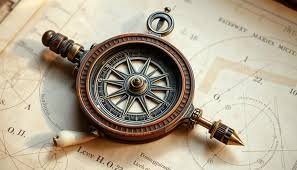A Bussola to measure angles within a circle is an essential tool in both academic and professional settings, particularly in geometry, engineering, and architecture. This instrument allows for the precise measurement and construction of angles within circular shapes, which are foundational in many fields of study. By understanding how to use a Bussola to measure angles within a circle, individuals can unlock the secrets of circle geometry, creating everything from basic geometric constructions to complex engineering designs.
In this blog post, we will explore the various applications of a bussola to measure angles within a circle, offering detailed insights into its importance and how it can be used to measure different types of angles in circular geometry. From simple constructions to advanced techniques, mastering this tool is key to understanding and applying the concepts of circle geometry in real-world scenarios.
What Is a Bussola to Measure Angles Within a Circle?
A Bussola to measure angles within a circle is typically a type of compass or protractor used for drawing and measuring angles within a circle. In simple terms, a bussola functions as a device that allows users to accurately draw arcs, create angular sections, and measure the distance between key points on the circle’s circumference. It is especially important in constructing geometrical shapes, measuring central angles, and understanding the relationship between different points on a circle.
The ability to measure angles within a circle accurately is crucial for a wide range of mathematical, architectural, and engineering applications. From designing circular layouts to solving complex geometry problems, the bussola to measure angles within a circle is a versatile and indispensable tool.
Understanding the role and capabilities of this tool is a crucial step in developing your overall knowledge of geometric principles. Whether you’re an aspiring engineer, architect, or geometry student, having a deep understanding of how to use a Bussola to measure angles within a circle will enhance your ability to create and analyze circular shapes with precision.
Why Is the Bussola Important for Measuring Angles Within a Circle?
Measuring angles within a circle plays a significant role in many practical applications. For example, when constructing regular polygons or determining the area of sectors, measuring precise angles is essential. The bussola to measure angles within a circle allows users to carry out these tasks with high accuracy.
Role in Geometry
In geometry, the concept of angles within a circle is essential for understanding the properties of circles, such as central angles, inscribed angles, and sector areas. The bussola to measure angles within a circle helps in drawing and measuring these angles accurately, making it easier to visualize and solve problems related to circle geometry. Geometric principles like these form the basis for many real-world applications, ranging from architecture to even certain manufacturing processes where exact measurements of circular components are required.
Practical Applications in Architecture and Engineering
For architects and engineers, using the bussola to measure angles within a circle is necessary when designing circular structures, such as arches, domes, or rounded walls. Accurate angle measurement ensures that all parts fit together seamlessly and function as intended. For example, when constructing a circular archway, ensuring that the segments of the arch are correctly aligned requires measuring precise central angles. Using the bussola to measure these angles ensures the structural integrity of the design.
Moreover, engineers designing circular gears, wheels, or even complex machinery systems benefit from understanding the relationships between angles and arcs in circular designs. Using the bussola to measure angles within a circle can make the process of engineering calculations more straightforward and accurate.
Using a Bussola to Draw Angles in a Circle
One of the most basic uses of a bussola to measure angles within a circle is drawing specific angles. To create a precise angle, the compass is set at the center of the circle, and the pencil is rotated along the circumference to draw the required arc. This simple but effective technique allows users to create well-defined angles that can be used in various geometric constructions.
How to Draw a 30-Degree Angle Using a Bussola
Let’s say you want to draw a 30-degree angle within a circle. First, position the point of the bussola at the circle’s center. Then, adjust the pencil to the outer edge of the circle and begin rotating the compass. By carefully measuring the angle using the tool’s scale, you can draw the arc at precisely 30 degrees. Repeat this process to construct additional angles or create specific geometric shapes.
In many cases, constructing angles with the bussola to measure angles within a circle is a necessary step in geometric proofs and constructions. The simplicity and accuracy of this technique make it one of the most common tasks for students and professionals working in geometry.
Significance of Drawing Angles
Drawing angles with a bussola to measure angles within a circle is the first step in many geometric constructions. It helps in creating proportional relationships between different parts of the circle, facilitating accurate designs in both academic and professional contexts. These angles also serve as the foundation for more advanced constructions, such as creating regular polygons and understanding the relationship between central angles and arcs.
Measuring Central Angles with a Bussola to Measure Angles Within a Circle
Central angles are those whose vertex is at the center of the circle. They are formed by two radii that connect the center of the circle to the circumference. Bussola to measure angles within a circle is ideal for measuring these angles as it provides an accurate method for determining the exact angle between two radii.
Step-by-Step Process for Measuring Central Angles
To measure a central angle, place the point of the bussola at the center of the circle. Then, use the pencil to mark two radii. Measure the angle formed between these two lines to determine the central angle. This can be done easily using the scale on the compass. The advantage of using the bussola to measure angles within a circle is the accuracy and precision it offers, particularly when dealing with smaller angles.
For example, when constructing a circle and marking points at regular intervals, using the bussola to measure angles within a circle can help determine the angle between each point. This technique is fundamental in understanding how circles are divided geometrically.
Applications of Central Angles
Central angles are crucial in calculating the area of sectors, determining the length of arcs, and constructing regular polygons. Accurately measuring these angles is essential in various fields, including engineering, navigation, and graphic design. For example, central angles are used in navigation to determine the angular separation between points on a map, particularly when working with circular navigation routes or sections of a globe.

Measuring Reflex Angles with a Bussola to Measure Angles Within a Circle
Reflex angles are the larger angles formed by two intersecting lines that extend beyond 180 degrees. These angles are critical in certain geometric problems and can be measured using the bussola to measure angles within a circle by first measuring the smaller internal angle and subtracting it from 360 degrees.
Measuring Reflex Angles in Circular Geometry
To measure a reflex angle, start by measuring the smaller internal angle with the bussola. Once this is done, subtract this measurement from 360 degrees to determine the reflex angle. This method is helpful in solving complex geometry problems that involve angles beyond 180 degrees.
In architecture, measuring reflex angles might come into play when designing certain curved structures or determining the angles of arcs that curve past the half-circle mark. By measuring the reflex angle using a bussola to measure angles within a circle, designers can ensure that every section fits precisely.
Why Reflex Angles Matter
Understanding and measuring reflex angles is important for solving problems related to tangents, secants, and other advanced circle-related concepts. The bussola to measure angles within a circle simplifies this process by allowing for accurate and consistent measurements. Reflex angles are often encountered in higher-level geometric and trigonometric problems, particularly when determining the intersection points of circular arcs or when working with polygons inscribed in circles.
Constructing Regular Polygons Using the Bussola to Measure Angles Within a Circle
Regular polygons, such as squares, pentagons, and hexagons, are often inscribed within circles in various design and engineering applications. The bussola to measure angles within a circle plays a key role in constructing these shapes by measuring equal central angles around the circle.
Step-by-Step Process for Constructing Regular Polygons
To construct a regular polygon, divide the circle’s total angle of 360 degrees by the number of sides in the polygon. For example, to construct a regular hexagon, divide 360 degrees by 6 to get 60-degree central angles. Use the bussola to measure angles within a circle to mark these 60-degree angles around the circle. Connect the points to form the hexagon.
This technique can be applied to other regular polygons as well, making it a versatile tool for geometric constructions. In engineering and architecture, these regular polygons are often used to design intricate structures, ensuring symmetry and balance.
Using a Bussola to Measure Angles in Arc Length Problems
Arc length problems often require determining the angle subtended by a given arc of a circle. By using the bussola to measure angles within a circle, you can easily measure the angle between the radii that define the arc, which is essential in solving these types of problems.
Solving Arc Length Problems
To solve arc length problems, first measure the arc’s length. Then, use the formula for the central angle:
θ=sr×180π\theta = \frac{s}{r} \times \frac{180}{\pi}θ=rs×π180
Where θ\thetaθ is the central angle, sss is the arc length, and rrr is the radius of the circle. The bussola to measure angles within a circle helps you determine the angle θ\thetaθ accurately, ensuring that your calculations are precise.
This technique is especially important in fields such as engineering, navigation, and physics, where understanding the relationship between arc length and angle is essential in calculations and designs.
Conclusion: Mastering the Bussola to Measure Angles Within a Circle
The bussola to measure angles within a circle is an invaluable tool for anyone working with circular geometry. Its ability to draw and measure angles accurately makes it essential for a wide range of tasks, from basic geometry to complex engineering designs. Understanding how to use the bussola to measure angles within a circle allows you to create precise geometric shapes, measure angles, and solve problems efficiently.
Whether you’re a student learning the basics of geometry, a designer working with circular patterns, or an engineer solving complex structural problems, mastering the use of a bussola to measure angles within a circle will significantly enhance your ability to work with circular geometry. With practice, you’ll be able to tackle any task that involves measuring angles within a circle with confidence and precision.

Pingback: BEST Pimoys Powder Puff BUY NOW - hayathomeessentials.com